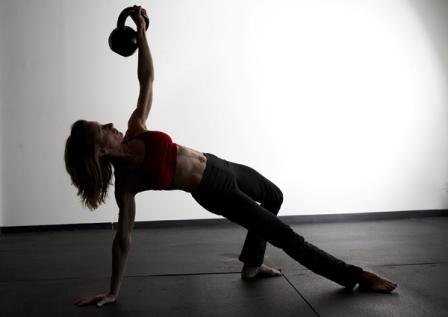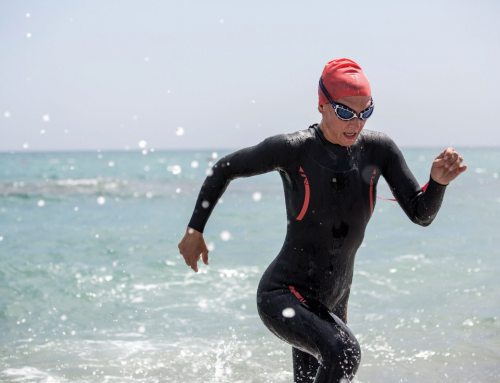
By Brett Cornwright
For the typical time-stretched endurance athlete, strength training usually occurs in the off-season, if at all. Workouts often involve a heavy dose of machines and isolated movements with free weights. During the racing season, and if the athlete is really motivated, he or she may get to the gym once or twice per week in an attempt to maintain what strength they managed to build over the winter.
There is an alternative to this mundane and ineffective routine, however, that is guaranteed to change your outlook on strength training. It is called a kettlebell, and it resembles a cannonball with a handle. Kettlebells are made of cast-iron and come in a variety of different weights, from 10 pounds (4 kilograms) to 106 pounds (48 kg).
As many professional triathletes, runners, and cyclists are discovering, including the king of cutting-edge, Lance Armstrong, there simply is no better strength and conditioning tool for your entire body.
“Kettlebells are unique from any other form of fitness equipment in a multitude of ways,” said Betsy Collie, owner and head trainer at Rapid Results Fitness in Durham. Collie is a Level II Russian Kettlebell Instructor (RKC II) and a Z-health Level I movement coach. “Kettlebells train the entire body at one time through full body movements. Unlike traditional gym equipment that focuses on isolating the body’s parts or performing cardio on stationery equipment, the kettlebell enhances the performance of all life’s activities.”
As you know, our body’s movements require more than one muscle to perform. They work in conjunction with one another, not in isolation. When you stick with machines and bodybuilding exercises, you are usually targeting one body part. With kettlebells, your entire body, including the core and the posterior chain, are effectively engaged.
“Due to the bell sitting below the handle instead of between it, the kettlebell’s weight is off-set in the hand, causing the body to use more muscles to hold and move the bell,” Collie said. “This causes the body to use more energy, which is convenient if one of your goals is to lose weight. Conversely, if one of your goals is trying to build strength, the kettlebell will literally force your body to use more muscles than performing similar exercises with barbells and dumbbells.”
Almost all kettlebell exercises begin with the hips, as this is where the power is generated in all sports, especially swimming, cycling and running. After training with kettlebells, swimmers find that their cores become much stronger, thus they have more power in the water. Cyclists find that their wattage outputs increase, despite no increase in volume or intensity on the bike. Runners often find that their posture and form is better, they have more spring in their legs, and their core, on which everything hinges, does not break down in the latter stages of a race.
“The reason kettlebell training translates to improved sports specific training is because of how kettlebell training works with your body,” Collie said. “It produces amazing results in all areas of sports specific training no matter what the sport. For example, in running the core gives out almost sooner than the legs and heart do. The kettlebell forces you to work your core on every set and every rep.”
Over time, many age group triathletes will develop overuse injuries from all of those miles. Because they have full-time jobs, families, and the stresses of the daily grind, protecting and building their bodies via strength training often falls by the wayside. Luckily, kettlebell workouts typically last 20 to 30 minutes, and your heart will be pumping the entire time. Thus, an athlete’s VO2 Max numbers can also improve with intense kettlebell work.
“The kettlebell can enhance any athlete for any sport,” said Tim Anderson, RKC II Instructor and Z-health III movement. Anderson is the co-owner of Outstanding Personal Training in Fuquay-Varina. “Endurance athletes can particularly benefit from kettlebells because of the tremendous cardiovascular training a kettlebell provides. Training with kettlebells can increase your VO2 Max, or your body’s ability to use oxygen. Kettlebells are also easy on the joints. They can save an endurance athlete’s joints from a lot of wear and tear.”
Many endurance athletes also might avoid lifting weights for fear of building too much muscle and becoming bulky. Kettlebells, however, are great for building a lean and athletically muscular body. They are also excellent at building strength endurance, which is something that is vital for all endurance athletes. Many are powerful on the bike or the run for the race’s opening miles. Maintaining that power throughout the race is where kettlebell training comes into play.
As far as preventing or treating injuries, kettlebell training cannot be beaten. Common injuries, like lower back pain, shoulder problems, plantar fasciitis, and tight hip flexors from sitting at a desk all day, are all effectively rehabilitated with kettlebells.
“Training properly with kettlebells can help prevent injuries,” Anderson said. “Kettlebells can be used to strengthen the whole body as well as correct asymmetries in strength and movement. Kettlebells are an amazing tool when it comes to preparing the body for performance and reducing the risk for injuries, but only when used properly with good form.”
And once again, all of these benefits to your core, your conditioning, and the strength in your legs and upper body, can be had in as little as 20 minutes three times per week.
# # #
Brett Cornwright is a freelance writer and marketing consultant. He is a two-time Ironman, and achieved a personal best of 11:06 at Ironman Florida in November. He writes a blog for beginner triathletes at http://www.triathlonjones.com/.





